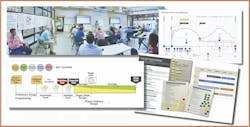Healthcare construction veteran creates next-level IPD process for hospital projects
Last year, the top 10 integrated project delivery AEC firms generated more than $2.1 billion in revenue from IPD contracts, according to BD+C’s latest Giants 400 ranking. And the healthcare sector, perhaps more than any other, continues to embrace this delivery method as a smoother journey toward faster and more efficient project management.
For example, last October 30, Penn Medicine officially opened its $1.6 billion hospital known as The Pavilion, the largest capital project in the University of Pennsylvania’s history. This 17-story, 1.5-million-sf project was completed under an IPD contract by a team dubbed PennFIRST, comprised of AEC firms that included architects HDR and Foster + Partners, engineer BR+A, and construction managers LF Driscoll and Balfour Beatty. This was also the first project in Philadelphia to construct mechanical racks and 504 bathroom pods off site, at a 60,278-sf warehouse/factory two miles from the hospital, according to Global Construction Review.
The Pavilion development project dates back to 2014, when Penn began reaching out to other healthcare systems about IPD. Penn then presented its project plans to AEC firms that were assured they’d be allowed to assemble their own teams. To create and sustain a collaborative environment, the team designed and built a 24,000-sf collocation office in the summer of 2015, out of which more than 100 team members worked together daily through the project’s completion.
“IPD isn’t for everyone,” says Ed Hanzel, LF Driscoll’s Vice President, whom BD+C interviewed with Matthew Guinan, an Executive with that firm. “A highly engaged invested owner certainly makes a difference.” Guinan adds that the work performed by the nine key trade partners that his firm brought on board under this contract accounted for half of the building’s dollar value.
At one point during the project, Penn wanted temporary treatment spaces for overflow patients due to Covid-19 surge planning, delivered ahead of the project’s completion. Within 23 days of that request, the building team set up 120 beds on multiple levels of the building. The building project itself was demobilized for 41 days. “One of the main reasons we were successful was because we were aligned under IPD to solve problems and overcome challenges together,” says Guinan.
At press time, The Pavilion hadn’t closed out yet, so neither Hanzel nor Guinan could comment on what the incentive pool distribution from cost savings would be to team members. Both execs agree, though, that contracts without performance incentives or fees at risk are different from true IPD. “Everyone’s interests have to be aligned from a risk and reward perspective,” says Hanzel.
CHANGING HUMAN BEHAVIOR TO MAKE IPD WORK
Can IDP work without those carrots and sticks? Denton Wilson thinks so.
Wilson, who has been planning, designing, and building healthcare facilities for more than 20 years, advocates for what he calls “structured collaboration,” which might best be described as IPD on steroids. Its framework is 14 minutely detailed processes that create “pillars of responsibility” for a “structure of authority.”
The most important of these processes are those that focus on choosing the right team partners, getting them working together as quickly as possible, and then motivating them psychologically through a series of team meetings. These meetings include what Wilson calls “retreats” or “retrospectives” that celebrate key project milestones and hash out solutions to problems within a “safe” environment that foments “vulnerable trust”—where team members are comfortable critiquing the project constructively without fear of recrimination or retribution.
In essence, the goal of structured collaboration, Wilson argues, is to change human behavior, to get team members and others to support each other without needing to have a financial stake in those decisions.
Wilson has refined this concept during his stints with The Beck Group and with several health systems in facilities management and AEC capacities. While at Beck Group, Wilson says he wrote the first IPD contract in Texas, for a project with Summit Health. More recently, Wilson was part of a team that delivered a project in late 2021 2½ to 3 months ahead of schedule and between $10 million and $12 million below what it would have cost without extensive offsite prefabrication.
In February, Wilson hung out his own shingle under the name IC3, a play on 1+1=3 (shorthand for integration plus collaboration equal individuals and teams exceeding their expectations).
And Atrium Health, one of Wilson’s former employers, is giving structured collaboration its stiffest test to date for the construction of a $1 billion, 1.2-million-sf replacement hospital complex at Atrium’s Carolinas Medical Center campus in Charlotte, N.C.
A ROSE BY ANY OTHER COLOR?
The following is a closer look at how team members and owners function under structured collaboration, based on interviews with Wilson and several AEC execs whose firms have worked on healthcare projects of varying sizes and complexities under contracts guided by that delivery approach.
At first glance, structured collaboration shares many of IDP’s traits and terminology: Target Value Design, big rooms, A3s, pull planning, Project Implementation Teams, Choosing by Advantage, Last Planner System. Its goal, like that of IDP, is to get design and building teams to do what the owner wants with the least friction and within agreed-upon budget and scheduling parameters.
Where these methods diverge is in the “how.” IPDs use contractual incentives and penalties to keep teams under those agreements on track, whereas Wilson’s process purports to exert psychology—and appeals to what he calls EQ, or emotional quotient—to drive team-member accountability.
That might seem fanciful; after all, AEC firms are in business to make money, so why would they relinquish whatever leverage they have on a project without compensatory motivation?
But there’s more than a little evangelism in Wilson’s urgings. He’s trying to change things with structured collaboration, not the least being the role of healthcare owners that, he contends, stifle creativity when they hire designers, engineers, builders, and contractors in isolation, instead of hiring as many team members as possible holistically so they are working together in the planning and early design stages to nip potential problems, delays, and cost overruns in their buds.
That sounds like IPD, too. The devil, though, is in the details, and Wilson has had some success convincing AEC firms and healthcare owners that it’s in their best interests to submit to structured collaboration—and the scoring that goes with it—without incentive pools. Conversely, “when a fee is at risk, trade partners don’t have many choices, and innovation goes out the window,” he has observed.
Wilson has found, though, that getting a healthcare system to that stage requires a realignment of project management and mindset to accept a hierarchy where “the owner has a seat, but not the only seat” at the decision-making table.
The market must also be ready to operate within this new paradigm. During his four-year stint with one health system, Wilson conducted 62 two-hour meetings with local AEC firms to gauge their readiness for the aggressive expansion that system was planning. And when that system sent out RFPs for one of its projects, it attached a detailed summary of the structured collaboration process it would be following, so AEC firms knew in advance what they’d be getting into.
The eventual general contractor on that project recalls filling out a “team oriented” questionnaire and then making a formal presentation to a group that included representatives from the health system, the project’s architect, and end users. (This GC’s executive vice president says his firm was hired shortly after the architect had been selected.)
A 2019 American Builders Quarterly article about structured collaboration noted its “RFC” (for “request for collaboration”) stage matched finalists with the health system’s architects, project managers, and consultants for three weeks to complete five research topics that were then scored. Wilson described this as “the show-me level,” and “a fantastic view of how teams engage and solve issues before they are contracted.”
FIND WILLING PARTNERS TO MAKE INTEGRATED PROJECT DELIVERY WORK
In a collaborative approach document for a recent project, to which Wilson gave BD+C access, one health system outlined the attributes it sought in AEC team members: mutual respect, transparency, team and self accountability, honesty, willingness, and dedication to task. These attributes make it easier to create a working environment informed by “vulnerable trust,” which Wilson characterizes as “having each other’s back” when it comes to improving the project as it progresses.
The “process” for this structured collaboration included “vision sessions” where measures of accountability and “conditions of satisfaction” are established. Teams were selected and organized into steering committees and project implementation groups that collocated into a big room where the owner’s goals and team members’ expectations were defined, and where everyone involved “commits to placing the project above any one team member’s interest.” In the big room, the core management team developed the project’s target criteria, budget, and milestone schedule for each project implementation team.
Team members were also surveyed monthly for their input on how things were going.
Only then was the project ready to transition into design, followed by the production of construction documents that enable work packages to be permitted, and then the construction phase, which was executed under the Lean Construction Institute’s Last Planner System to measure progress against project targets, and then make adjustments as needed.
One health system official explains that Target Value Design and Delivery are “the sum of all these parts” that hold each team member accountable for staying on the agreed-upon budget. To do so, “you have to be willing to look under every rock,” and follow “gold-plated guidelines that are more about performance and less about rigid product mandates.”
PULLING BACK TO PROCEED
Wilson is big on scoring. When asked about the lean tools he favors, he cites A3s, a Toyota-inspired management method that begins as a blank sheet of paper for listing a project’s current state, desired state, impacts on the building team, and the team’s recommendations for moving forward. This is part of a continuing education that keeps teams in sync. And the scoring of each A3 is what creates structured collaboration.
Wilson also refers to pull planning, where a project is “pulled back to its beginning” so the team has the time to evaluate results. These retrospectives typically occur during key points of a job, such as when drawings are issued for construction, the building is topped out, the building’s drying-in period, and 60 to 90 days before move in.
At these retrospectives, teams use performance baselines to measure what is and isn’t working. But, says Wilson, they aren’t allowed to converse initially; instead, they stick green, yellow, or red dots on a big board in the room to indicate what’s going well and what requires rethinking. Wilson calls this “slowing down to speed up,” and believes this method induces a level of candor that might not be reached otherwise by verbal back and forths. These meetings also allow team members to celebrate achievements in ways that boost their esprit de corps.
“It works really well,” remembers a GC whose firm participated in one retrospective on a recent project, for which it worked in both a physical and virtual big room. “You get all the benefits without the legal gymnastics. And it’s a good step toward a true IPD.” The design-architect on that same project says this process “helps everyone spend money in a smarter way [to improve] the quality of the project within a budget.” He adds that structured collaboration has become his firm’s delivery preference on larger-scale design contracts.
PLANNING FOR PREFAB IN HEALTHCARE CONSTRUCTION
Wilson has estimated that there’s as much as 57 percent waste in most project budgets. The ways to reduce that waste, he suggests, include BIM protocols and offsite manufacturing.
Prefabrication has played a starring role in a number of structured collaboration projects that Wilson and other team members have worked on. Between 50 and 60 percent of a recent bed tower project was prefabricated, including its glass, acrylic, and brick exterior panels, its bathroom pods for patient rooms, and the tower’s mechanical racking systems.
The mechanical contractor was present during this project’s design phase, “guiding the designer toward where we wanted them to go,” says its director of VDC and fabrication. That contractor also allowed the GC’s key trade partners to come into its factory to assemble the multi-trade racks. Structural collaboration “gave us the opportunity to introduce prefab to our subs,” says the GC’s executive vice president.
And by developing A3s and discussing ideas in team meetings, the architect on this project determined that prefabbing the building’s stairs “would not have improved the project’s critical path, and would have been more expensive,” recalls the architect’s managing principal. He contends that prefabrication, in a market where it was not common at the time, would have been harder without structured collaboration.
Prefabrication also provides alternatives for projects in markets where labor shortages persist. “We’re going to have to be smarter” and use labor more efficiently, says the abovementioned mechanical contractor, who is now convinced that some form of structured collaboration “is the wave of the future” for his market.
OVERCOMING OWNER SKEPTICISM OF IPD
A few months ago, Wilson conducted a virtual two-day workshop for a large architecture and planning firm, which he says was trying to understand why it kept losing out on IDP contract bids. “The first thing I asked them was did they know what owners wanted, and they didn’t. Conversation over,” says Wilson, ruefully.
The future of structured collaboration as a sustainable project management model still hinges on winning over owners to integrated delivery, which for some remains problematic. A senior project manager for one of the industry’s largest design and consulting firms, which served as an owner’s rep for a recent healthcare project that was managed under structured collaboration, says some owners are “nervous” about bringing on contractors and subs, and asking them for fair pricing, before documents are completed.
Other AEC sources interviewed for this article wonder if incentives will eventually need to be reintroduced to get project teams to work together willingly.
These caveats aside, converts to the structured collaborative delivery approach say it’s worth pushing for. Josh Storey, a former Senior Principal with Stantec, who recently started his own project management consulting business in Charlotte, N.C., says he would without hesitation lead owners “looking for a better mousetrap” to structured collaborative delivery, “which is an easier way of doing it, provides better information, and avoids risk.”
“If you make a project more efficient for your team partners, they are going to want to work with you again,” notes the aforementioned mechanical contractor. “The old way [of project delivery] is less appealing to us now.”


